CCNA – EIGRP Questions 2
Here you will find answers to EIGRP Questions – Part 2
Note: If you are not sure about EIGRP, please read my EIGRP tutorial.
Question 1
A router has learned three possible routes that could be used to reach a destination network. One route is from EIGRP and has a composite metric of 20514560. Another route is from OSPF with a metric of 782. The last is from RIPv2 and has a metric of 4. Which route or routes will the router install in the routing table?
A. the OSPF route
B. the EIGRP route
C. the RIPv2 route
D. all three routes
E. the OSPF and RIPv2 routes
Answer: B
Explanation
When one route is advertised by more than one routing protocol, the router will choose to use the routing protocol which has lowest Administrative Distance. The Administrative Distances of popular routing protocols are listed below:
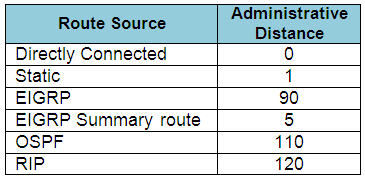
Question 3
Refer to the exhibit. Based on the exhibited routing table, how will packets from a host within the 192.168.10.192/26 LAN be forwarded to 192.168.10.1?

A. The router will forward packets from R3 to R2 to R1
B. The router will forward packets from R3 to R1
C. The router will forward packets from R3 to R1 to R2
D. The router will forward packets from R3 to R2 to R1 AND from R3 to R1
Answer: D
Explanation
From the routing table we learn that network 192.168.10.0/30 is learned via 2 equal-cost paths (192.168.10.9 &192.168.10.5) -> traffic to this network will be load-balancing.
Question 4
Refer to the exhibit. The company uses EIGRP as the routing protocol. What path will packets take from a host on 192.168.10.192/26 network to a host on the LAN attached to router R1?
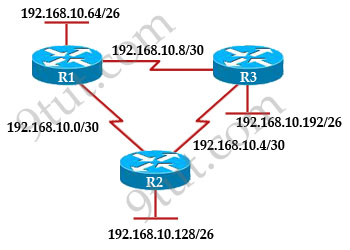
R3# show ip route
Gateway of last resort is not set
192 168.10.0/24 is variably subnetted, 6 subnets, 2 masks
D 192.168.10.64/26 [90/2195456] via 192.168.10.9, 00:03:31, Serial0/0
D 192.168.10.0/30 [90/2681856] via 192.168.10.9, 00:03:31, Serial0/0
C 192.168.10.4/30 is directly connected, Serial0/1
C 192.168.10.8/30 is directly connected, Serial0/0
C 192.168.10.192/26 is directly connected, FastEthernet0/0
D 192.168.10.128/26 [90/2195456] via 192.168.10.5,00:03:31, Serial0/1
A. The path of the packets will be R3 to R2 to R1.
B. The path of the packets will be R3 to R1 to R2.
C. The path of the packets will be both R3 to R2 to R1 and R3 to R1.
D. The path of the packets will be R3 to R1
Answer: D
Explanation
Host on the LAN attached to router R1 belongs to 192.168.10.64/26 subnet. From the output of the routing table of R3 we learn this network can be reach via 192.168.10.9, which is an IP address in 192.168.10.8/30 network (the network between R1 & R3) -> packets destined for 192.168.10.64 will be routed from R3 -> R1 -> LAN on R1.
Question 5
Refer to the exhibit. A packet with a source IP address of 192.168.2.4 and a destination IP address of 10.1.1.4 arrives at the HokesB router. What action does the router take?
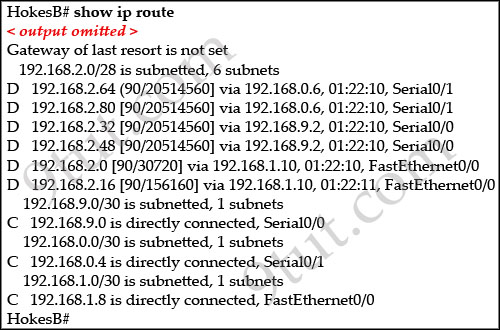
A. forwards the received packet out the Serial0/0 interface
B. forwards a packet containing an EIGRP advertisement out the Serial0/1 interface
C. forwards a packet containing an ICMP message out the FastEthemet0/0 interface
D. forwards a packet containing an ARP request out the FastEthemet0/1 interface
Answer: C
Explanation
When a packet with destination IP address of 10.1.1.4 arrives at HokesB, it will look up in the routing table to find the most specific path. In this case no path is found so HokesB must inform to the source host that the destination is unreachable on the interface it has received this packet (it is Fa0/0 because the network 192.168.2.0/28 is learned from this interface). So the best answer here should be C – send an ICMP message out of Fa0/0.
Question 6
The EIGRP configuration in the Glencoe router uses a single network statement. From the output shown in the graph would advertise these networks in EIGRP?
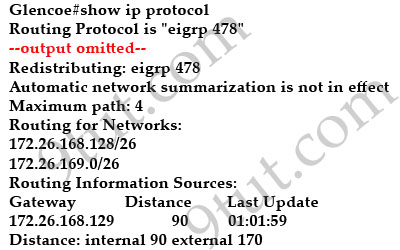
A. network 172.26.168.0 area 478
B. network 172.26.0.0
C. network 172.26.168.128 0.0.0.127
D. network 172.26.168.128 area 478
Answer: B
Explanation
The single “network …” statement used to advertise network 172.26.168.128/26 & 172.26.169.0/26 must cover both of them -> it is “network 172.26.0.0″. Notice the “network 172.26.168.128 0.0.0.127″ command is valid but it only covers from 172.26.168.128 to 172.26.168.255.
Question 7
Refer to the exhibit. From RouterA, a network administrator is able to ping the serial interface of RouterB but unable to ping any of the subnets attached to RouterB. Based on the partial outputs in the exhibit, what could be the problem?
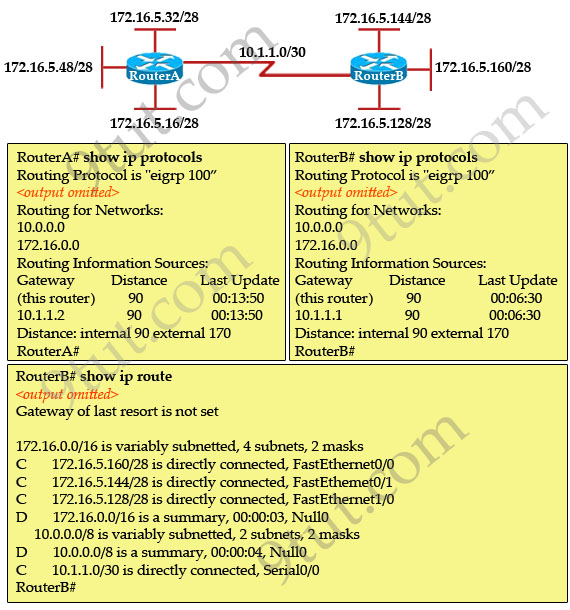
A. EIGRP does not support VLSM.
B. The EIGRP network statements are incorrectly configured.
C. The IP addressing on the serial interface of RouterA is incorrect.
D. The routing protocol has summarized on the classful boundary.
E. EIGRP has been configured with an invalid autonomous system number.
Answer: D
Explanation
From the output of “show ip route” command on RouterB, we learn that RouterB does not learn any networks in RouterA. Also the “172.16.0.0/26 is a summary, 00:00:03, Null0″ line tells us this netwok is summarized.
Note: EIGRP performs auto-summarization each time it crosses a border between two major networks. For example, RouterA has networks of 172.16.x.x. It will perform auto-summarization when sending over network 10.1.1.0/30, which is in different major network (172.16.0.0/16 and 10.0.0.0/8 are called major networks in this case).



wow there are lots of new eigrp question…
thanks 9tut.
Q. 6
Why not 172.26.168.0 0.0.1.255 ?
instet of 172.26.0.0.
Please, wish to your help.
thank-you.
Please some one can explain Q. no 7 more elaborately.
Thank-you.
@look
Q6. eigrp can work like rip when advertising networks.
“172.26.168.0 0.0.1.255″ would be correct, but it’s not one of the given options.
Q7. notice at the advertised networks. they are classful (172.16.0.0) on both routers
bot routers have subnets on that big network.
the problem appears when the router has to decide where to forward the packets too. it will choose the local interfaces as they have the lowest administrative distance.
to overcome this problem you should use “no auto-summary” under the eigrp router config.
Thak-you Xallax,
Count hear the administrative distance. Thank-you xallax. Bye.
dont seem to understand question 3 atll please explain further would be greatly appreciated
Question 6 in exam
@landon @q3
D is correct . As you see router could reach 192.168.10.0 by 2 paths via 10.9 and 10.5.
& if you look as [ 90/2681856] are AD/FD which are same also
By default EIGRP can use 4 equal paths to load balance.
to is my exam
Is there a problem with Q2? :)
I am not understand this question please brief explain for q3 (Answer)
As soon as possible you will explain for my question
pz help
@jaathu
Q3 says that R3 needs to send packets to 192.168.10.1
That ip address belongs to the 192.168.10.0/30 subnet, which is the P2P link between R1 and R2.
As you can see both R1 and R2 are directly connected to the 192.168.10.0/30 network; assuming that the cost (bandwith, delay… ) of the links between R3→R1 or R3→R2 are the same, that means that R3 has 2 equal-cost paths to reach the 192.168.10.0/30 network where the address 192.168.10.1 belongs to. And it will start load-balancing meaning 1 packet to R1 then 1 packet to R2 and so on.
That can be confirmed by looking at the output of the routing table on the line that says
=======================================
D 192.168.10.0/30 [90/2681856] via 192.168.10.9 s0/0
[90/2681856] via 192.168.10.5 s0/1
=======================================
I think that the confusion is how we humans see and interpret the network diagram and how routers actually interpret the network.
We as humans see the network diagram and immediately think that the ip address 192.168.10.1 its closer to R3 through R1 since it is configure on a R1 interface. Physically the address seems to be closer to R3 through R1. That’s how we tend to see things. But that’s thinking in a human mindset.
Routers dont work that way. Routers dont advertise single ip addresses and dont advertise on which interface or what router they are assigned. They just advertise the networks.
In this case once you configure EIGRP on all the routers, all of them will advertise its directly connected networks. Both R1 and R2 are directly connected to 192.168.10.0/30 and will send that information to R3 separately. They are not sending the ip address 192.18.10.1 they are sending the whole network.
R3 will receive those 2 updates, and DUAL will start doing its job to determine which path goes to the routing table and which one will be the backup route. In this case DUAL determined that both paths between R3→R1 and R3→R2 have the same cost. That’s why both routes are showing in the routing table.
If R3 needs to send a packet to either 192.168.10.1 on R1 interface or 192.168.10.2 on R2 interface, R3 will ONLY care about the network those addresses belong to that is 192.168.10.0/30.
R3 will look at its routing table and see that it can go either through R1 or R2.
Load-balancing will start
OPTION D IS CORRECT
Sorry for the long expanation but I really hope it helps you understand Q3 answer
Thank you so much for your help
Please you will send least relation question or dumps for ccna exam end your valuable tips you will share for me
Your explanation are very nice work and keep it up. l like it.
my email id – sjaathu01@gmail.com
Q6 was in exam. kudos to 9tut.
Nice one 9tut!
@xallax
I don’t quite understand Q7. I read your previous post where you explaned it but I still don’t quite understand how answer D was determined. Can you elaborate it a little more than what posted before?
Q7. notice at the advertised networks. they are classful (172.16.0.0) on both routers
bot routers have subnets on that big network.
the problem appears when the router has to decide where to forward the packets too. it will choose the local interfaces as they have the lowest administrative distance.
to overcome this problem you should use “no auto-summary” under the eigrp router config.
@raj
RIPv1 deals with classful networks.
example of classful networks:
7.0.0.0/8
125.0.0.0/8
164.0.0.0/16
164.7.0.0/16
200.0.0.0/24
200.0.55.0/24
200.55.55.0/24
ospf/eigrp can advertise both classful and classless networks.
example of classless networks:
7.0.16.0/20
125.0.0.128/25
164.0.0.252/30
164.7.128.0/17
200.0.0.64/26
200.0.55.32/27
200.55.55.224/27
networks like “7.0.0.0/9″, “164.0.0.0/30″ or “200.55.55.0/30″ are also classless.
what does classless mean? it means that only a portion of the full network is advertised (a subnet is advertised).
let’s get back to the question… what was the problem there? both routers had subnets on the same big network.
there wouldnt have been any problems if the classless networks (subnets) were advertised.
to make sure classless networks are advertised you use “no auto-summary” if the routing protocol in use is capable to do so.
this is one of the problems with RIPv1 :)
please make sure you understand the difference between classless and classful
@xallax
I understand the difference between classful and classless clearly but I don’t exactly understand what exactly in the output that allowed us to determine the routing protocol has summarized on the classful boundary. I see 172.16.0.0/16 showing Null in the RouterB show ip route output but eventhough it was classful didn’t that cover all the other hosts in routerA?
@raj
look at the output from both routers:
routing for networks: 10.0.0.0 / 172.16.0.0
@xallax
I saw that both RouterA and B have routing for networks: 10.0.0.0 & 172.16.0.0 but how is that exactly causing a problem? Did it cause a conflict since RouterA and B network adresses were not specific enough for the hosts directly connected to them? Its not sure if its a host on Router A or a host on Router B because hosts on both Routers start with 176.16.x.x ?
@xallax
Nevermind I think I figured it out now after piecing all the explanations together.
Because both Router A and B have have routing for networks as 10.0.0.0 & 172.16.0.0 it causes a conflict. Routers A and B are unable to decide where to forward the packets too. By default it will choose the one with the closest administrative distance. Show ip route for Router A would come up with a similar result with all the hosts directely attached to it with nothing showing up for anything attached to router B through Router A. If they were more specific in the network address it might of worked.
Is this on the right track?
@raj
R1 has to send a package to 172.16.20.5
R1 has 172.16.0.0/16 directly connected
R2 is advertising that is has 172.16.0.0/16 too.
R1 will obviously send the package out its local interface because it has the lowest AD. what if 172.16.20.5 was on a subnet connected to R2? thats what causes the problem, lack of specificity.
@raj
your above post is correct :)
@xallax
Thanks for explaining it thoroughly.
Q7: Could be worded: Look at show ip route –> it lists all of the connected networks and none of the networks learned from router A
So i just took my CCNA exam today and i got an 801/1000 which means i failed by one question. There were some IPV6 questions that i didnt see in the collisio or jericho dumps as well as on 9tut. the test is 295.00 soo when you take it be prepared for it as much as possible. iplan to take my CCNA again in a couple weeks.
Labs: EIGRP (AS221), ACL 2, and Show commads lab
48 questions and 90 minutes
GOOD LUCK to evryone who is taking it soon. Still alot of similarities from the DUMPS just worded differently
@d@v3.FRIDAY
9tut isn’t sufficient to pass CCNA exam???
@jhyakuchi: Read books and take a practice with real equipment or Packet Tracer/GNS. 9tut is a one of many tools to check yourself before exam and it has some hints to help successfully take an exam.
Q6 – Whilst the answer “B” – network 172.26.0.0 – is correct – it doesn’t yield the the result shown in the exhibit. If you use the single line as above, the result of the “sh ip route” command will be something like :
…
Routing for Networks:
172.26.0.0
….
Just a pointer.
Q7 – Couple of points. The routes 172.26.0.0/16 are designated at “D” routes – EIGRP (not directly connected). They are EIGRP summary routes with administrative distance of 5. More so, they direct all packets to the NULL interface – i.e. packets that match this route they go nowhere.
So as it stands RouterB has no idea that the 172.26.5.16/28, 172.26.5.32/28 or 172.26.5.48/28 networks exit on RouterA. Any packet destined for this networks is then matched to the EIGRP summery route and is sent into oblivion!
As said, the way around this is to issue the “no auto-summary” command in the EIGRP router config.
This is the classic case of the discontiguous network – two similar networks separated by a third completely different network. Further, this wouldn’t have happened if the joining network between RouterA and RouterB would have been in the 172.26.x.x network (doesn’t need to be 172.26.5.x as these are subnetted network from the 172.16.x.x clasfull network)
Q3
Shouldn’t the last octet of the next hop routers’ ip addresses be .10 and .6 instead of the .9 and .5 which are R3′s own serial interfaces’?
@T48174
The answer is YES. This is clearly a mistake. Right after the word via the “next hop address” should be listed and not the addresses assigned to the exit interfaces of R3.
Nonetheless, this should not affect the resolution of this question.
This question is testing your ability of interpreting the routing table and be able to identify equal cost paths to a same destination by looking at the routing table.
If you were able to detect that mistake…… you definitely dont have to worry about not being able to solve this question or any question that involves interpreting a routing table.. :-)
Passed CCNA with 986/1000. Complacency lost me top marks – I think I lost it on the EIGRP lab (the easiest one!) because I didn’t check for passive interfaces. If you get that lab, remember to do this. The Acme & Jericho dumps are 100% valid although the Acme dump is definitely enough. Bear in mind there are one or two incorrect answers in the Acme dump, but if you know your stuff and read this site, you should be able to weed them out. The study tools I used are the Todd Lammle book, CBT Nuggets and I built myself a lab from ebay, although Packet Tracer seemed to be enough for most things. Packet Tracer doesn’t seem to allow you to create extended VLANs over 2000 for some reason – I had to do these on my real switch. I also practised labs from 101 Labs for the CCNA exam which are harder than anything the exam will throw at you and it also gives you good practice with using the IOS until the commands become second nature.
All in all, if you take your time and do the things that I’ve listed above, not only will you pass your exam, but you will also find that the exam doesn’t really stretch your knowledge like some of the listed materials do. If you’re serious about being a good Cisco engineer and not just someone who wants to pass the exam then I suggest looking at some of the material above.
In saying that if you ONLY use this site and the Acme dump, you will have more than enough to pass the exam, but it won’t necessarily put you in good stead to go out into the real world and be a good engineer. Personally, I’m going to take 2 weeks off, then start CCNP ROUTE in May – onwards and upwards. Good Luck to you all.
For the record, Todd Lammle’s method of subnetting is awesome. He will get you subnetting in split seconds with you barely thinking about it!
q7 good because it make me think
. The network aoadnistrmtir has discovered that packets destined for servers on the 172.16.254.0 network are being dropped by Router2. What command should the aoadnistrmtir issue to ensure that these packets are sent out the gateway of last resort, Serial 0/0/1?***ip classless
@9tut
Again, this time EIGRP questions 2 what happened to the missing question 2?
Aj
Q3 today in the exam
A good question is No 5, requires good thought and understanding, is also in the exam.
Question 1 answer is wring…
below is the sequence for route selection…
Check longest prefix if tie
Check AD if tie
Check Metric
Q1 was in my exam today
Hi all, I am taking CCNA 640-802 exam first time on 30/05/2012. Could anyone please send me latest dumps which are valid for UK? My e-mail address is puneet_gill84@yahoo.co.uk. Many thanks.
I`m going to take the exam next monday, could anyone please send me the latest dumps to figared@hotmail.com
hi 9tut and xallax..
I would like to ask for your help on the question below.
http://i45.tinypic.com/263ws41.gif
Please explain why the answer is B.
thanks in advance.
@jay
that’s what the “show ip eigrp topology” command does: show all the routes.
there is just 1 path via serial0, option A can be ruled out.
the command displays all routes, not just the backup ones. option C is false
if there was a variance configured then there could’ve been more than just 1 successor towards 192.168.81.0/24. option D is false too
thanks xallax.
I PASSED CCNA EXAM TODAY THANKS TO ALL MIGHTY ALLAH
960/1000
hi xallax, i still didn’t get ur mail about the comment on how u pass ur exam.one more thing:are you a jw?
@bola
study study study, that’s the only way to pass the exam. most people that fail did not quite understand the concepts.
what is a “jw”?
Q6 – The Grammatical error in this question is grossly confusing as in actual fact no question is clearly asked.